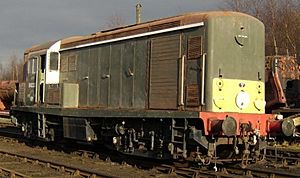British Rail Class 15 facts for kids
Quick facts for kids BTH Type 1British Rail Class 15 |
|
 |
|
| Sole surviving Class 15 no D8233 seen at Baron Street Loco Shed, East Lancashire Railway, February 2006 | |
| Power type | Diesel-electric |
|---|---|
| Builder | British Thomson-Houston at Clayton Equipment Company |
| Build date | 1957–1961 |
| Total production | 44 |
| Configuration | Bo-Bo |
| UIC classification | Bo'Bo' |
| Gauge | 4 ft 8 1⁄2 in (1,435 mm) |
| Wheel diameter | 3 ft 3+1⁄2 in (1.003 m) |
| Minimum curve | 3.5 chains (70 m) |
| Wheelbase | 31 ft 0 in (9.45 m) |
| Length | 42 ft 0 in (12.80 m) |
| Width | 9 ft 2 in (2.79 m) |
| Height | 12 ft 6 in (3.81 m) |
| Locomotive weight | 69 long tons (70.1 t) |
| Fuel capacity | 400 imp gal (1,800 L; 480 US gal) |
| Prime mover | Paxman 16YHXL |
| Generator | BTH RTB10858 |
| Traction motors | BTH 137AZ, 4 off |
| Transmission | DC generator, DC traction motors |
| Multiple working | ★ Blue Star |
| Top speed | 60 mph (97 km/h) |
| Power output | Engine: 800 hp (597 kW) At rail: 627 hp (468 kW) |
| Tractive effort | Maximum: 37,500 lbf (166.8 kN) |
| Locomotive brakeforce | 31 long tons-force (310 kN) |
| Train brakes | Vacuum |
| Career | British Railways |
| Number | D8200–D8243 |
| Axle load class | RA 4 |
| Retired | 1968–1971 |
The British Rail Class 15 was a type of diesel locomotive. It was also known as the BTH Type 1. These powerful engines were designed by a company called British Thomson-Houston.
They were built by two other companies: the Yorkshire Engine Company and the Clayton Equipment Company. Construction took place between 1957 and 1961. These locomotives were an important part of modernizing Britain's railways.
Contents
What is a Diesel-Electric Locomotive?
A diesel-electric locomotive is a special type of train engine. It uses a diesel engine to power a generator. This generator then makes electricity. The electricity powers electric motors that turn the wheels.
This design is different from older steam trains. It is also different from purely electric trains. Diesel-electric trains can run on tracks without overhead electric lines.
Building the Class 15 Locomotives
The Class 15 locomotives were part of a big plan. This plan was to replace steam trains with modern diesel and electric ones. British Railways ordered many new types of locomotives.
A total of 44 Class 15 locomotives were built. They were given numbers from D8200 to D8243. Each one was designed to be strong and reliable for its time.
Who Built Them?
The main design came from British Thomson-Houston (BTH). They were an engineering company. The actual building work was shared.
The Yorkshire Engine Company built some of them. The Clayton Equipment Company built the others. This was a common way to build many trains quickly.
What Were They Used For?
Class 15 locomotives were mainly used for pulling freight trains. Freight trains carry goods, not people. They were strong enough to pull heavy loads.
They also sometimes pulled local passenger trains. This was especially true on less busy lines. They helped move goods and people across Britain.
Where Did They Operate?
These locomotives mostly worked in the eastern parts of England. They were often seen around London and East Anglia. They helped connect towns and cities.
Their job was to keep goods moving. This was important for industries and businesses. They were a common sight on the railway lines of the time.
Why Were They Retired So Soon?
The Class 15 locomotives had a relatively short working life. They were retired between 1968 and 1971. This was only about 10-14 years after they were built.
There were a few reasons for this. Newer, more powerful locomotives were being developed. Also, some parts of the Class 15 engines caused problems.
Engine Issues
The Paxman 16YHXL engine was used in these trains. This engine sometimes had reliability issues. This meant the trains needed more repairs.
It was more cost-effective to replace them. Newer designs were more efficient. They also required less maintenance.
The Sole Survivor
Most of the Class 15 locomotives were scrapped. However, one locomotive survived. This is number D8233.
It was saved and is now preserved. You can sometimes see it at the East Lancashire Railway. It's a great way to see a piece of railway history.
Images for kids
-
Sole surviving Class 15 no D8233 seen at Baron Street Loco Shed, East Lancashire Railway, February 2006




